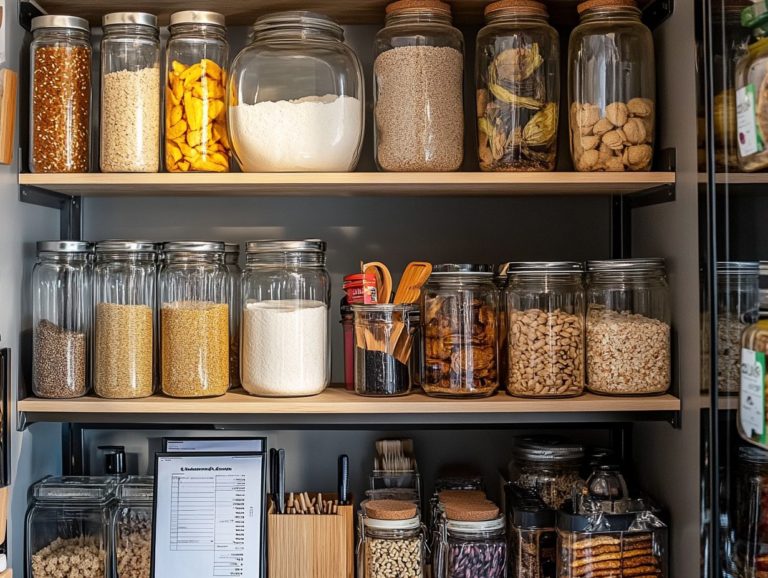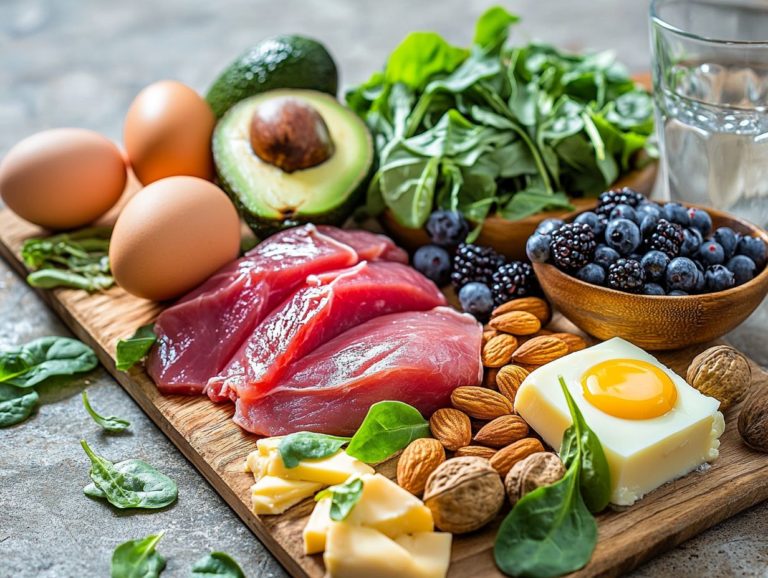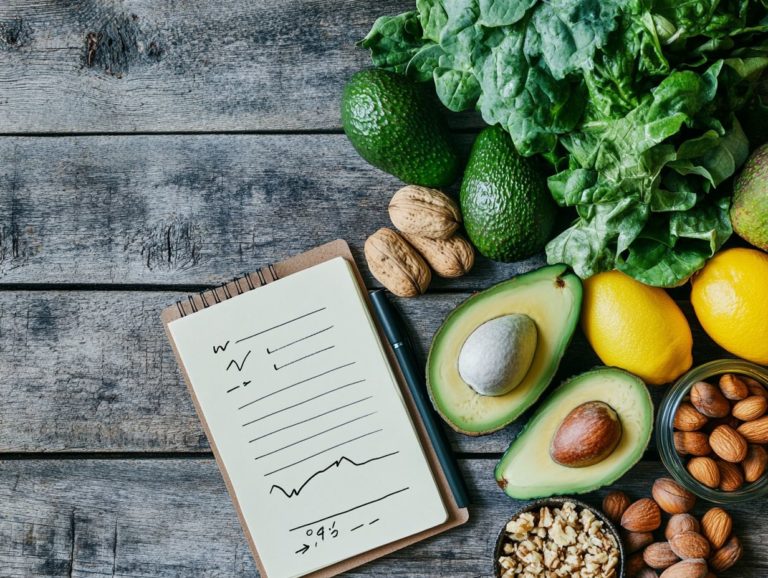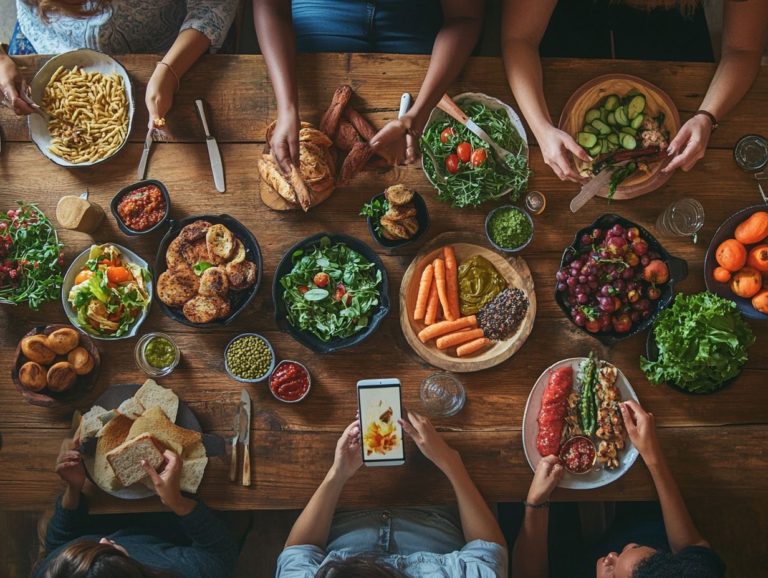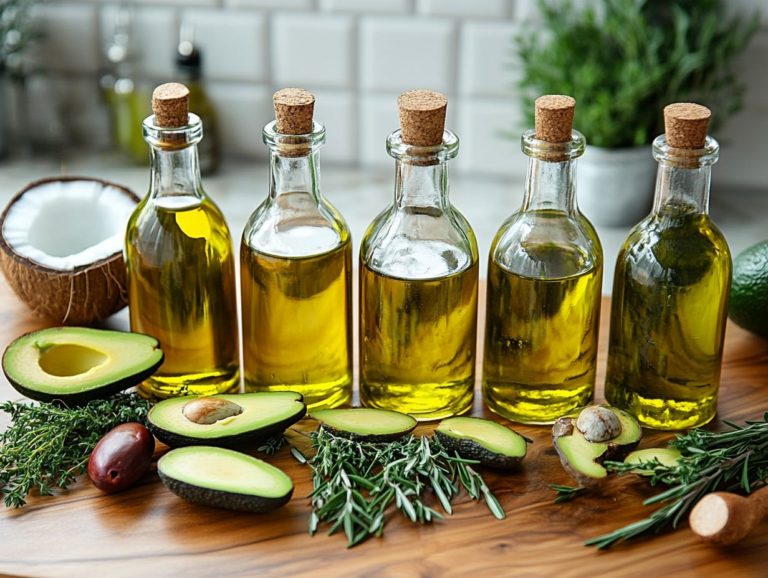Keto Diet and Eating Out: Your Questions Answered
The Keto diet has surged in popularity, celebrated for its ability to promote weight loss and enhance specific health conditions. Sources like the Mayo Clinic and nutrition experts such as Scott Keatley and Kendra Whitmire support this.
But what does the Keto diet entail, and how can you navigate dining out while adhering to its principles?
This article delves into the essentials of the Keto diet, highlighting its benefits and outlining the foods you should embrace or avoid. You’ll discover keto-friendly foods like olive oil, salmon, and almonds.
You will also uncover practical tips for making Keto-friendly choices when eating at restaurants, allowing you to stay on track without compromising flavor or enjoyment.
Contents
- Can the Keto Diet Help with Certain Health Conditions?
- What are the Guidelines for the Keto Diet?
- Recommended Macronutrient Ratio for the Keto Diet
- Tips for Sticking to the Keto Diet When Eating Out
- How to Make Keto-Friendly Choices at Sit-Down Restaurants?
- What are Some Tips for Successfully Eating Out on the Keto Diet?
- Plan Ahead and Do Your Research
- Ask for Modifications or Substitutions
- Don’t Be Afraid to Speak Up and Ask Questions
- Be Mindful of Portion Sizes and Ingredients
- Frequently Asked Questions
- What is the Keto Diet and how does it work?
- Can I eat out while following the Keto Diet?
- What are some keto-friendly options at fast food restaurants?
- How can I make sure I am staying in ketosis while eating out?
- Can I still enjoy desserts while following the Keto Diet, as recommended for conditions like epilepsy by organizations such as the Epilepsy Foundation?
- Is it okay to have cheat meals while following the Keto Diet?
Key Takeaways:

- The Keto Diet is a low-carb, high-fat diet that encourages the body to burn fat for fuel instead of carbohydrates. This is supported by studies published in the Journal of Clinical Endocrinology and Nutrition & Metabolism.
- The Keto Diet can help with weight loss and may also have benefits for certain health conditions.
- When eating out on the Keto Diet, plan ahead, ask for modifications, and be mindful of portion sizes, carbs, and ingredients. For instance, you might ask for a cauliflower crust instead of traditional pizza dough.
What is the Keto Diet?
The Keto diet, scientifically recognized as a high-fat, moderate-protein, and low-carb eating regimen, is designed to shift your body into a state where it uses fat for energy instead of carbohydrates, known as ketosis.
This dietary approach has gained popularity for good reason it’s not only about weight loss but also offers a range of health benefits, including increased energy levels and improved mental clarity.
Medical professionals frequently recommend the ketogenic diet for conditions like epilepsy and certain metabolic disorders, making it a versatile choice for those looking to improve their overall well-being. The Epilepsy Foundation notes its effectiveness in reducing seizures.
What are the Benefits of the Keto Diet?
The benefits of the keto diet are numerous, primarily due to its unique approach to nutrition, which limits carbohydrate intake and promotes the consumption of healthy fats. This can lead to significant weight loss and various health improvements.
You may experience enhanced mental clarity, sustained energy levels, and reduced cravings as your body adapts to ketosis and becomes fat-adapted.
However, it s crucial to remain mindful of potential health risks and nutritional deficiencies that could arise without proper guidance, such as kidney stones and irregular periods.
How Does the Keto Diet Help with Weight Loss?
The keto diet can be your ally in weight loss by significantly reducing your carbohydrate intake, prompting your body to enter ketosis. In this state, fat becomes your primary energy source.
This change not only accelerates fat burning but also helps you manage hunger signals and curb cravings for unhealthy foods, making it easier to stick to your dietary goals.
By choosing keto-friendly foods like olive oil, salmon, avocado, and Greek yogurt, you can effectively enhance your weight loss journey.
During ketosis, your liver converts fats into ketones, which serve as an alternative fuel for both your brain and body. This highlights the importance of incorporating healthy fat sources into your diet.
As you navigate this transition, you might encounter the infamous keto flu, which includes symptoms like fatigue, headaches, and irritability. Don’t worry, as these effects are often temporary and can be eased with proper hydration, electrolyte intake, and possibly exogenous supplements.
Finally, prioritizing leafy greens, nuts, and seeds will boost your nutrient intake and support a successful adaptation to this dietary approach.
Can the Keto Diet Help with Certain Health Conditions?
The keto diet has captured your attention for its remarkable potential to assist in managing various health conditions beyond just weight loss. These include epilepsy, polycystic ovary syndrome (PCOS), and certain metabolic disorders.
Research suggests that the ketogenic diet can help stabilize insulin levels and promote hormonal balance, offering significant benefits for individuals grappling with these issues. It s essential for you to consult with a healthcare professional to tailor the diet appropriately and prevent any nutritional deficiencies or health risks.
For instance, studies indicate that the ketogenic diet can dramatically reduce the frequency of seizures in those with drug-resistant epilepsy, showcasing its clinical effectiveness. Regarding PCOS, the diet has been linked to weight loss and improved menstrual regularity, addressing some of the most troublesome symptoms.
Individuals with metabolic disorders like type 2 diabetes frequently experience better glycemic control while adhering to a keto regimen. However, it s vital that you seek medical supervision.
Healthcare providers can monitor your progress and make necessary adjustments, ensuring the diet supports your long-term health goals without any adverse effects.
What are the Guidelines for the Keto Diet?
To successfully embrace the keto diet, you must adhere to specific guidelines that prioritize a high-fat, moderate-protein, and low-carb eating plan. This ensures nutritional balance and helps steer clear of deficiencies.
This means thoughtfully selecting keto-friendly foods that are rich in healthy fats, such as olive oil, heavy cream, and nuts. You should diligently limit your carbohydrate intake to achieve and maintain ketosis.
By understanding these principles, you can confidently make informed choices that maximize your health journey with the keto diet! Avoiding potential pitfalls like nutritional deficiencies and health risks is crucial.
In conclusion, the keto diet offers a promising approach to managing various health conditions. With the right guidance and commitment, it can be a transformative lifestyle change that enhances your overall well-being.
What Foods are Allowed on the Keto Diet?

On the keto diet, you need to focus on a variety of keto-friendly foods. These foods should be high in healthy fats, moderate in protein, and very low in carbohydrates.
Consider options like olive oil, fatty fish such as salmon, nuts like almonds, and dairy products like Greek yogurt. These foods provide essential nutrients and help you reach ketosis effectively.
Avocados and coconut oil are fantastic sources of healthy fats that not only elevate the flavor of your meals but also boost their nutritional value. For protein, lean cuts of beef, chicken, and eggs should be at the forefront of your selections.
Leafy greens like spinach and kale are nutrient-rich vegetables that strengthen your diet without loading on the carbs.
Choosing high-quality products is crucial for your success on the keto diet! Grass-fed meats and organic produce should be your go-to. Doing so ensures your body receives optimal nutrients, paving the way for a healthier and more successful keto lifestyle.
High-quality vegetable oils, such as olive oil, can be beneficial. Saturated fats in moderate amounts from sources like red meat are also helpful.
What Foods Should be Avoided on the Keto Diet?
To successfully maintain the keto diet, you must steer clear of certain foods that are high in carbohydrates, as they can sabotage the ketosis process. Think sugary snacks, grains, and starchy vegetables.
Fast food options are often prime offenders, packed with hidden carbs and unhealthy fats that can easily derail your efforts. By being mindful of your carbohydrate intake and avoiding these pitfalls, you significantly enhance your chances of achieving sustained ketosis and reaping its associated health benefits.
Beyond these common culprits, you might be surprised to find that processed foods, sweetened beverages, and even certain fruits can harbor unexpected amounts of carbohydrates that make staying in ketosis a challenge.
Instead, prioritize whole foods like leafy greens, avocados, and low-carb nuts, which will provide essential nutrients without jeopardizing your dietary goals. Avoiding fast food and sugary snacks is key to maintaining ketosis.
To combat those pesky cravings, consider meal prepping and keeping keto-friendly snacks like almonds readily available; these strategies can be game-changers. By creating an environment that encourages healthier food choices, you ll find it much easier to resist high-carb temptations, making your journey toward a successful keto lifestyle not only more manageable but also more enjoyable.
Recommended Macronutrient Ratio for the Keto Diet
The recommended macronutrient ratio for the Keto Diet typically consists of around 70-75% of your calories coming from healthy fats. 20-25% should come from moderate protein, and just 5-10% from carbohydrates. This balance is essential for keeping your body in a state of ketosis.
Embracing this high-fat, low-carb approach means focusing on foods rich in nutrients and carefully monitoring your carbohydrate intake. This will help optimize fat metabolism and maintain your energy levels.
To effectively calculate your daily intake based on your personal goals, start by determining your total daily caloric needs. Consider factors like your age, gender, activity level, and weight loss objectives. Once you ve established your calorie requirements, apply the Keto macronutrient ratio to those totals.
For example, if you set your daily caloric intake at 2,000 calories, you would aim for approximately 1,400 calories from fats, 400-500 from protein, and a modest 100-200 from carbohydrates.
Maintaining this ratio is crucial for promoting consistent weight loss. It enables your body to switch to burning fat effectively without being sidetracked by excess carbohydrates. This process, known as ketosis (a metabolic state where your body burns fat instead of carbs), is crucial for the Keto Diet.
Tips for Sticking to the Keto Diet When Eating Out
Navigating the Keto Diet while dining out can present its challenges. However, with the right strategies and insights into keto-friendly options, you can still enjoy your favorite meals! Even experts like Scott Keatley and Kendra Whitmire recommend planning ahead.
Many restaurants and fast food chains now offer meals that can be tailored to suit a ketogenic lifestyle. This allows you to savor the experience of eating out without straying from your dietary goals.
By proactively selecting dishes and making thoughtful modifications, you can uphold your commitment to the Keto Diet, even in social settings.
What are Some Keto-Friendly Options at Fast Food Restaurants?
When you re on the hunt for keto-friendly options at fast food restaurants, focus on meals that are low in carbohydrates and high in healthy fats. Think burgers without buns, salads drizzled with olive oil dressing, and grilled chicken selections.
Many fast food chains now offer customizable meals, allowing you to tailor your order to meet your dietary needs while still enjoying a satisfying meal. You might also consider incorporating Greek yogurt as a low-carb side option.
By being discerning and requesting ingredient adjustments, you can indulge without the guilt that often accompanies dining out.
At McDonald’s, explore their variety of salads. Order them without croutons and opt for grilled chicken to whip up a delicious, low-carb feast.
Over at Taco Bell, the Power Menu Bowls become keto-friendly with a simple request to hold the rice and beans. This gives you a hearty blend of meat, cheese, and guacamole.
Even Wendy’s gets in on the action, offering customization for their burgers. You can enjoy them wrapped in crisp lettuce instead of a bun. These thoughtful modifications not only satisfy your cravings but also keep your carb count in check.
Enjoy dining out while adhering to your keto lifestyle! Explore keto-friendly options on your next outing.
How to Make Keto-Friendly Choices at Sit-Down Restaurants?
Making keto-friendly choices at sit-down restaurants requires a bit of strategy when it comes to your menu selections. Don t hesitate to request modifications that align with your dietary needs. Opt for dishes rich in healthy fats, like those drizzled with olive oil, and steer clear of starchy sides to maintain your ketogenic lifestyle while still enjoying a delightful evening out. According to the Mayo Clinic, these adjustments can significantly aid in adhering to a Keto diet while dining out.
Many restaurants are willing to accommodate your requests, such as swapping fries for a crisp side salad, allowing you to stick to your plan without compromising your dining experience. This approach is supported by research published in the Journal of Clinical Endocrinology, which highlights the benefits of dietary modifications.
As you look at the menu, consider exploring grilled or roasted protein options, which typically come without the added carbs. Effectively communicating your dietary requirements is essential don t hold back from sharing your preferences with the staff, as they may offer valuable insights or even suggest enticing off-menu options.
Be careful! Don t assume that all sauces or dressings are inherently keto-friendly. By being proactive about understanding the ingredients used, you can prevent unexpected carb intake and ensure that your meal aligns perfectly with your keto goals. Publications like Nutrition & Metabolism provide valuable insights into maintaining a moderate-protein diet while ensuring low carbohydrate consumption.
What are Some Tips for Successfully Eating Out on the Keto Diet?

Successfully navigating the dining experience while on the Keto diet demands a thoughtful blend of preparation, awareness, and clear communication. By planning ahead and researching restaurants that embrace keto-friendly options, you can elevate your dining experience while honoring your dietary commitments. This is particularly beneficial for those managing Diabetes or PCOS.
It s crucial to take the initiative to request modifications to menu items and to remain vigilant about portion sizes and hidden ingredients. This way, you can confidently stay within your carbohydrate limits and enjoy your meal without compromise.
Plan Ahead and Do Your Research
Planning ahead and conducting thorough research are essential for successfully navigating the Keto diet while dining out. Familiarizing yourself with local restaurants that offer keto-friendly options enables you to make informed decisions, minimizing the temptation to indulge in impulse eating simply because a menu is convenient.
With a bit of preparation, you can select establishments that cater to your dietary needs and explore a variety of meal options in advance, ensuring a truly satisfying dining experience. The Epilepsy Foundation also recommends such preparation to manage ketogenic diets effectively.
Using specialized apps and websites that highlight keto dining options can significantly streamline this journey. Resources like Yelp, KetoFinder, or even dedicated social media groups for keto cuisine can provide invaluable insights into where to dine. These platforms often feature user-generated reviews and recommendations for dishes that align perfectly with ketogenic principles.
By proactively planning your meals, you not only cultivate healthier eating habits but also open yourself up to delightful culinary experiences.
Knowing what to expect at each dining venue equips you to enjoy your meals without the anxiety of veering off your dietary path.
Share your experiences or tips related to dining out on keto diets to encourage others in their journey!
Ask for Modifications or Substitutions
When dining out on the keto diet, it’s vital for you to feel enabled to request modifications or substitutions from the menu to align with your dietary needs. Many restaurants are quite accommodating and will happily adjust dishes to fit your ketogenic lifestyle. For example, you can ask for a burger without the bun or swap out fries for a side of vegetables. This proactive approach allows you to maintain the integrity of your diet while still enjoying a delightful meal.
Clearly communicating your specific dietary restrictions is essential to ensure your meal aligns with your personal health goals. For instance, you might want to request salad dressing on the side or choose grilled options over fried ones to avoid hidden carbs.
Stating your need for gluten-free ingredients or low-carb sauces can significantly enhance your dining experience and avert any potential mishaps that could derail your keto journey. By openly discussing your preferences with the restaurant staff, you foster a better understanding, enabling them to cater more effectively to your dietary goals.
Don’t Be Afraid to Speak Up and Ask Questions
It s crucial to confidently express your d dietary needs when dining out on the keto diet to ensure your meal aligns perfectly with your health goals. Don t hesitate to ask questions about ingredients, preparation methods, and hidden sugars lurking in sauces or dressings, as this information can significantly impact your carbohydrate intake.
By effectively communicating with restaurant staff, you set yourself up to make informed choices that support your keto journey. Engaging with the waitstaff not only equips you with vital details, but it also creates a collaborative atmosphere where your dietary preferences are respected.
When you clearly articulate your needs, you ll often find that staff members are more than willing to assist, offering recommendations or suggesting modifications to existing dishes. This dialogue can uncover options that might not be immediately apparent on the menu, ensuring you enjoy a satisfying meal without compromising your dietary commitments.
Remember, your comfort and satisfaction are paramount, and asking the right questions can unlock a world of delicious keto-friendly choices.
Be Mindful of Portion Sizes and Ingredients
Being mindful of portion sizes and ingredients is crucial for maintaining your keto diet, especially when dining out, where restaurant servings can often balloon beyond typical meal sizes. Understanding how to spot hidden carbs, like those sneaky ones lurking in sauces or dressings, will enable you to make better choices and avoid accidentally exceeding your carbohydrate limits.
By staying aware of portions and ingredient contents, you can relish your meals without veering off your dietary path. To manage portion sizes effectively, consider using smaller plates or bowls. This simple trick can play with your mind and make you feel satisfied with less food.
Regarding hidden ingredients, don t hesitate to ask for meal modifications like getting sauces on the side or opting for olive oil instead of those pre-made dressings. Familiarizing yourself with common terms that signal the presence of sugar or starch in menu items can also be quite beneficial.
Keeping carb-counting apps close at hand can streamline your tracking process, ensuring that sticking to the keto lifestyle remains not only achievable but also enjoyable.
Frequently Asked Questions
What is the Keto Diet and how does it work?

The Keto Diet is a low-carb, high-fat diet that focuses on forcing the body to burn fat for energy instead of carbohydrates. By limiting carbohydrates, the body enters a state called ketosis, where it uses stored fat for energy instead of sugar. This results in weight loss and increased energy levels. This diet has been extensively studied and documented in medical journals, including the Journal of Clinical Endocrinology.
The Keto Diet is a popular low-carb, high-fat diet. Eating out can be challenging, but there are many options available, and you can find answers to your concerns in keto diet and meal plans.
Can I eat out while following the Keto Diet?
Yes, it is possible to eat out while following the Keto Diet, a low-carb, high-fat diet often suggested by the Mayo Clinic. It may require some planning and modifications to your meal choices. Most restaurants offer keto-friendly options such as salads, grilled meats, and vegetables. Watch for hidden carbs in sauces and dressings.
What are some keto-friendly options at fast food restaurants?
Some keto-friendly options at fast food restaurants include bunless burgers, grilled chicken sandwiches without the bun, salads with grilled meat and low-carb dressing, and steamed vegetables as a side dish. Experts like Scott Keatley emphasize avoiding breaded and fried items, as well as sugary drinks and sauces.
How can I make sure I am staying in ketosis while eating out?
To stay in ketosis while eating out, make sure to choose low-carb, high-fat options and avoid high-carb foods. Ask for any sauces or dressings on the side to control the amount you consume. Nutritionists like Kendra Whitmire suggest staying hydrated and steering clear of sugary drinks while dining out.
Can I still enjoy desserts while following the Keto Diet, as recommended for conditions like epilepsy by organizations such as the Epilepsy Foundation?
Absolutely! You can indulge in delicious keto-friendly desserts like sugar-free cheesecake, dark chocolate, and berries with whipped cream. Greek yogurt with a low-carb sweetener is another tasty option. However, these should be enjoyed in moderation, as they can still contain calories and affect ketosis if consumed in large quantities.
Is it okay to have cheat meals while following the Keto Diet?
Having occasional cheat meals while following the Keto Diet is okay, as long as it is not a regular occurrence. Research from journals like the Journal of Clinical Endocrinology and Nutrition & Metabolism suggests listening to your body and ensuring the cheat meal does not turn into a cheat day or week. Getting back on track with your keto meals after a cheat meal is crucial to maintain the benefits of the diet, like managing conditions such as Diabetes and PCOS.
Next time you dine out, remember these tips to enjoy your meal while sticking to your Keto goals!

